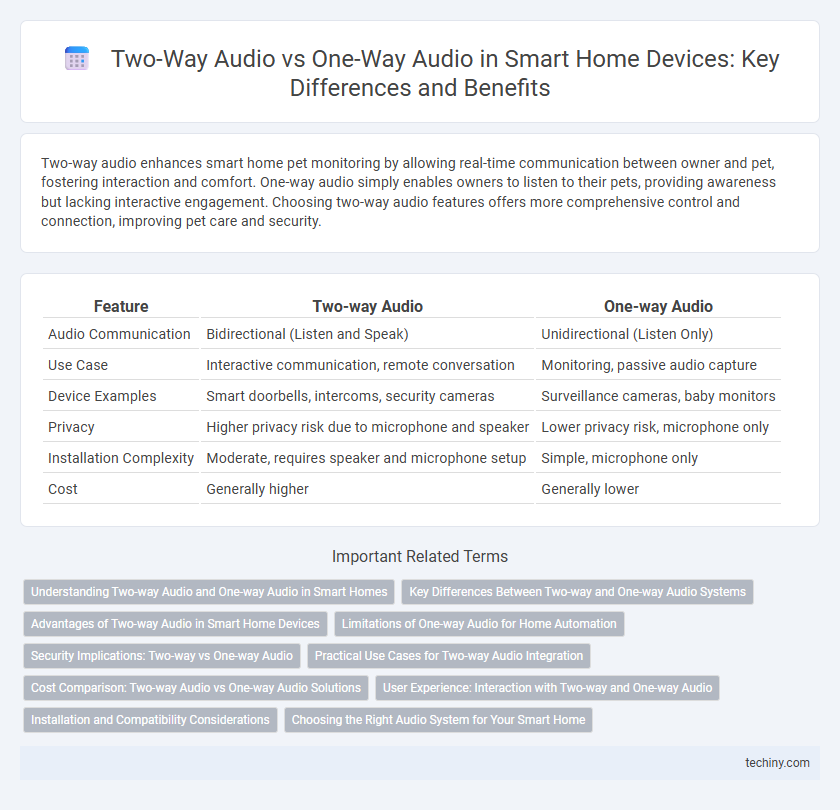Two-way audio enhances smart home pet monitoring by allowing real-time communication between owner and pet, fostering interaction and comfort. One-way audio simply enables owners to listen to their pets, providing awareness but lacking interactive engagement. Choosing two-way audio features offers more comprehensive control and connection, improving pet care and security.
Table of Comparison
| Feature | Two-way Audio | One-way Audio |
|---|---|---|
| Audio Communication | Bidirectional (Listen and Speak) | Unidirectional (Listen Only) |
| Use Case | Interactive communication, remote conversation | Monitoring, passive audio capture |
| Device Examples | Smart doorbells, intercoms, security cameras | Surveillance cameras, baby monitors |
| Privacy | Higher privacy risk due to microphone and speaker | Lower privacy risk, microphone only |
| Installation Complexity | Moderate, requires speaker and microphone setup | Simple, microphone only |
| Cost | Generally higher | Generally lower |
Understanding Two-way Audio and One-way Audio in Smart Homes
Two-way audio in smart homes enables real-time communication, allowing users to both listen and speak through devices like smart doorbells and security cameras, enhancing security and convenience. One-way audio only supports listening, limiting interaction to monitoring sounds or alerts without the ability to respond directly. Understanding the distinction helps homeowners choose the right smart devices for effective communication and control within their smart home ecosystem.
Key Differences Between Two-way and One-way Audio Systems
Two-way audio systems enable real-time communication by allowing both parties to send and receive audio signals, ideal for interactive smart home security cameras and intercoms. One-way audio systems transmit sound in a single direction, typically used for monitoring or alerts without interaction, such as baby monitors or alarm systems. The key difference lies in interactivity and functionality: two-way audio supports dynamic communication, while one-way audio serves primarily passive listening or alert purposes.
Advantages of Two-way Audio in Smart Home Devices
Two-way audio in smart home devices enables real-time communication between users and visitors, enhancing security and convenience by allowing immediate interaction without physical presence. It supports remote monitoring and control, such as instructing delivery personnel or deterring intruders, which one-way audio systems lack. This interactive feature improves overall user experience by integrating voice communication seamlessly into smart home ecosystems.
Limitations of One-way Audio for Home Automation
One-way audio in smart home systems restricts communication by allowing only sound transmission from the source to the receiver, limiting interactive capabilities. This lack of feedback hampers real-time conversations, reducing the effectiveness of security and monitoring features such as intercoms or voice alerts. Consequently, one-way audio impairs user control and responsiveness, making it less suitable for dynamic home automation environments.
Security Implications: Two-way vs One-way Audio
Two-way audio enhances smart home security by enabling real-time communication, allowing homeowners to interact directly with visitors or potential intruders, which can deter unauthorized access. One-way audio, typically limited to surveillance microphones, provides only passive audio monitoring without the ability to respond, reducing interactivity in security situations. Implementing two-way audio systems increases control over security responses but requires robust encryption to prevent hacking and unauthorized eavesdropping.
Practical Use Cases for Two-way Audio Integration
Two-way audio enhances smart home security by allowing real-time communication between residents and visitors or delivery personnel, reducing the need for physical interaction. It enables remote monitoring and immediate response to potential intruders, increasing safety and convenience. Practical applications include greeting guests at the door, instructing delivery drivers, and deterring suspicious activity through direct verbal warnings.
Cost Comparison: Two-way Audio vs One-way Audio Solutions
Two-way audio systems typically cost more than one-way audio solutions due to the added hardware components like microphones and speakers, as well as more complex software for real-time communication. One-way audio devices, which only support audio monitoring or alerts, generally have lower manufacturing and installation expenses, making them more budget-friendly for basic security needs. Considering long-term costs, two-way audio may also involve higher data usage and maintenance fees, but it provides enhanced interaction capabilities for smart home security and convenience.
User Experience: Interaction with Two-way and One-way Audio
Two-way audio enhances user experience by enabling real-time communication, allowing homeowners to listen and respond instantly through smart home devices, which improves security and convenience. One-way audio limits interaction to listening only, making it suitable for monitoring but less effective for active engagement. The immersive interaction facilitated by two-way audio supports remote control scenarios, such as speaking to delivery personnel or family members, enriching the overall smart home ecosystem.
Installation and Compatibility Considerations
Two-way audio systems require devices equipped with both microphones and speakers, demanding compatible smart home hubs or apps to facilitate seamless communication. One-way audio setups typically involve simpler installation with a microphone-only configuration, compatible with most basic security cameras and monitoring systems. Ensuring device compatibility with existing smart home ecosystems like Alexa, Google Home, or Apple HomeKit is crucial for effective functionality in two-way audio installations.
Choosing the Right Audio System for Your Smart Home
Two-way audio systems enable real-time communication between the smart home user and visitors, enhancing security and convenience by allowing both listening and speaking through devices like smart doorbells and security cameras. One-way audio systems only transmit sound in a single direction, typically from the sensor to the user, suitable for simple monitoring without interaction. Selecting the right audio system depends on your security needs, with two-way audio offering interactive capabilities and one-way audio providing straightforward audio surveillance.
Two-way Audio vs One-way Audio Infographic

 techiny.com
techiny.com